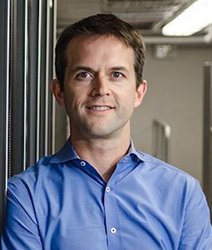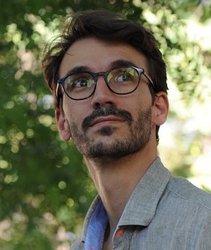2019 De Logi Grant Awards
Quantum Noise-Free Measurements
Rana Adhikari

Funding from the De Logi grant award allowed Adhikari (pictured left) and his team to begin developing a prototype of a possible next-generation gravitational wave detector called LIGO Voyager, in years 2019-2021 when the National Science Foundation, for political reasons, was not providing any new funding for such LIGO R&D efforts. Once complete, the prototype will be housed in the Caltech-LIGO 40m lab.
Explanation of Voyager: Emerging technologies in low-dissipation optical coatings, low-vibration cryogenics, and other areas have opened a path to delivering a broadband improvement in strain sensitivity by a factor of ∼5 over the Advanced LIGO design. To take advantage of these developments, Adhikari has assembled a design concept for LIGO Voyager. Currently, the LIGO Scientific Collaboration is studying the feasibility of a LIGO Voyager upgrade near the end of this decade, in the context of the proposed 2030s next generation detectors: the U.S. led Cosmic Explorer (20 – 40 km) and the European led Einstein Telescope (10 km and underground). The outcome of this study will determine whether the current LIGO instruments will be upgraded into the Voyager configuration. As part of this study, the limits of the room temperature interferometers (based on the Advanced LIGO system) are also being examined as a potential alternative to Voyager.
If the Voyager detector being prototyped by Adhikari and his team with the help of De Logi funds, is not implemented, some variant of its technology will very likely be implemented in the Cosmic Explorer and Einstein Telescopes.
Publications
R. X. Adhikari, K. Arai, A. F. Brooks, C. Wipf, O. Aguiar, P. Altin, B. Barr, L. Barsotti, R. Bassiri, A. Bell et al. (2020) A cryogenic silicon interferometer for gravitational-wave detection.
Full list of publications from this project.
Engineering Red Blood Cells to Cure HIV Infection
Pamela Bjorkman

Supported by a De Logi grant award, Bjorkman (pictured left) and her lab set out to develop a bioengineering-driven approach to functionally cure HIV infection. They engineered red blood cells (RBCs) to mimic the cells that HIV normally infects that present a dense area of HIV's host receptors (CD4 and CCR5) on their surface. The idea is that HIV would bind to and infect these RBCs instead of the immune cells that the virus normally infects and thereby deplete HIV from the infected person's body. In contrast to other cell types, RBCs don't contain a nucleus and other elements that HIV requires to replicate, so the idea was that the engineered RBCs would lure the virus to a "dead end." The support has allowed them to publish their proof-of-concept results for generating and evaluating Red Blood Cells (RBC) viral traps in vitro. In addition the support has allowed the lab to explore other avenues in their pursuit to develop a decoy-based functional cure therapy against HIV.
Publications
Hoffmann, Magnus A. G. and Kieffer, Collin and Bjorkman, Pamela J. (2021) In vitro characterization of engineered red blood cells as viral traps against HIV-1 and SARS-CoV-2.
Quantum Machine Learning for Chemistry and Materials
Thomas Miller
Co-Investigators: Anima Anandkumar, Kaushik Bhattacharya, Andrew Stuart and Yisong Yue

De Logi funding allowed Miller (pictured left) and his Co-Investigators to pursue the use of rigorous and general machine learning methods to address the quantum electronic structure problem that underpins the entirety of molecular and materials simulation. Current approaches employ physics-based methods which solve quantum mechanical equations to describe the behavior of atoms and molecules. While powerful, these methods come at extraordinary computational costs and human-time costs. A major outcome of this project has been the development of the OrbNet method, which combines deep learning with quantum mechanics to dramatically reduce the computation cost of accurate solutions of the Schrodinger Equation for the description of chemical and biomolecular properties. The method has received acknowledgement from journals in terms of Editor's Pick highlights; it has been featured by the CEO of NVIDIA 3 times in his semi-annual keynote addresses as a pathbreaking method for AI-driven drug design; and it has contributed to accurate large-scale simulations (up to 1B atoms) of the SARS-CoV2 virion in work that was selected as a finalist for the 2021 Gordon Bell Prize for COVID Research.
Publications
Z. Qiao, M. Welborn, A. Anandkumar, F. R. Manby, and T. F. Miller III, (2020) OrbNet: Deep learning for quantum chemistry using symmetry-adapted atomic-orbital features
J. Chem. Phys., 153, 124111 (Editor's Pick)
Full list of publications from this project.
Search for a Meteorite from Planet Mercury
Francois Tissot
Co-Investigator: Benjamin Weiss

The De Logi grant award allowed Tissot (pictured left), Weiss and their teams to investigate carefully selected meteorites in search of a sample from planet Mercury and determine whether any of these candidates were actually Mercurian. A family of meteorites, known as aubrites, showed great initial promise owing to their bulk elemental composition and mineralogy, reduced nature, and, for specific specimens, their potentially younger age compared to other meteorites. Over the three-year duration of the award, Tissot and Weiss developed novel methods, and directed a coordinated effort to scrutinize the isotopic composition, as well as the paleomagnetic and chronologic record of selected aubrites. Thanks to a unique and stringent test algorithm for the successful identification of Mercurial samples, the team was able to determine that none of the selected aubrites were in fact Mercurian samples. The establishment of the unique team and workflow to assess the possible Mercurian origin of future meteorites finds/falls, means that the impact of this funding will continue in the years to come.
Publications
Hyung, Eugenia and Tissot, François L. H. (2021) Routine high-precision Nd isotope analyses: an optimized chromatographic purification scheme.
